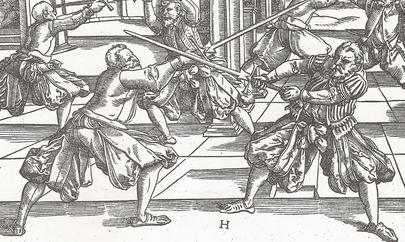Windthauw
Contents |
Wind/wound Strike
Longsword
A composite strike which combines an unterhauw wound back down into a slice back down on the opposite diagonal. This strike uses a form of “setting aside” (absetzen) and involves “winding” (winden)
Execution
The canonical description of the technique is performed thus:
- Beginning from wechsel on the left, against an attacker striking an oberhau/zornhau rechts.
- Step forward with the left, cutting up with an unterhau, stopping their blade with an ochs position..
- Side step backward to the left, winding your sword down to your lower left, striking him across the arms (see the image)
- Continue the movement through schranckhut
- Continuing the motion, cut back over with a sturtzhauw to the head or krumphauw to the hands.
Notes
In the winding movement it is useful to flick the tip to the side, imparting a little momentum on the opponent's blade and opening their arms to attack more easily.
The winding reversal can also be used from a high bind from below in this way.
Note also that the wind can be a smooth slicing action over the arms/head, or can be a wind which looks more like a tight Krumphauw over their arms in a thumbed hewing motion.
Applications
In which the 'student' demonstrates their knowledge to the 'teacher'; the technique is simplified in many areas to the unterhauw winding to a slice, and this simplified version forms the application for this technique.
Application 1: Windthauw
In this application the initial Unterhauw is a Taker in the Onset, followed by a Zornhauw to the head or arms as a Hitter in the Middle then stepping away with a Krumphauw as a Taker in the Withdrawal. In this case the fencer is acting in the Nach at the beginning of the technique.
| Teacher | Student |
|---|---|
| Vom tag, left leg forward | Wechsel, right leg forward |
| Passing Step forward with the right leg, Zornhauw | Turn the hip to a cross stance and Unterhauw parry up to ochs or Einhorn, catching the blade high. Note: a passing step may also be used. |
| Side Step out to the side with the left leg, wind pommel low left for a Zornhauw/slice from above to the arms or head. | |
| Keep the blade moving through to the left through schranckhut, Passing Step backward with the right leg, Krumphauw to the blade/arms as you withdraw. | |
| Withdraw (Abzug) with a defensive high cut or a guard. |
Dussack
The winding cut with the dussack is a generic winding in the cut. The canonical version is described as follows:
- Cut a high cut from the left
- Halfway through the cut wind the hand to the low left so that the cut winds down toward the other diagonal.
